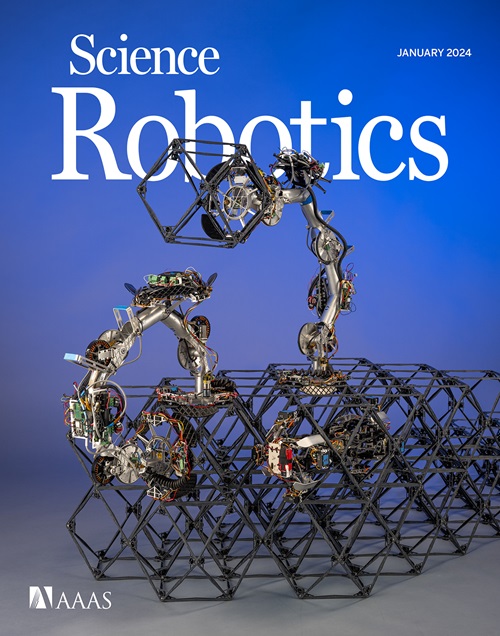OpenExo:开源模块化外骨骼,增强人体功能
IF 27.5
1区 计算机科学
Q1 ROBOTICS
引用次数: 0
摘要
尽管可穿戴机器人外骨骼领域正在迅速扩张,但仍有一些进入壁垒阻碍了许多人在这一领域进行研究,最终阻碍了发展。其中最主要的是外骨骼从概念到实现的漫长而昂贵的开发过程,以及广泛的专业知识的必要性。此外,许多外骨骼是为特定用途而设计的,并且局限于实验室环境,限制了设计系统的灵活性,以适应回答新问题和探索新领域。为了解决这些障碍,我们提出了OpenExo,这是一个开源的模块化无约束外骨骼框架,可以访问设计过程的各个方面,包括软件、电子、硬件和控制方案。为了证明该外骨骼框架的实用性,我们对该系统进行了多种配置的台式和实验验证测试,包括仅髋部倾斜辅助、仅踝关节室内和室外辅助、髋部和踝关节负载运输辅助以及仅肘部举重辅助。软件架构、电气元件、髋关节和鲍登电缆传输设计以及控制方案的所有方面都可以免费提供给其他研究人员访问、使用和修改,以解决可穿戴外骨骼领域的研究问题。我们的希望是,OpenExo将加速新的外骨骼设计和控制方案的开发和测试,同时鼓励其他人,包括那些可能被拒之门外的人,探索新的和独特的研究问题。本文章由计算机程序翻译,如有差异,请以英文原文为准。

OpenExo: An open-source modular exoskeleton to augment human function
Although the field of wearable robotic exoskeletons is rapidly expanding, there are several barriers to entry that discourage many from pursuing research in this area, ultimately hindering growth. Chief among these is the lengthy and costly development process to get an exoskeleton from conception to implementation and the necessity for a broad set of expertise. In addition, many exoskeletons are designed for a specific utility and are confined to the laboratory environment, limiting the flexibility of the designed system to adapt to answer new questions and explore new domains. To address these barriers, we present OpenExo, an open-source modular untethered exoskeleton framework that provides access to all aspects of the design process, including software, electronics, hardware, and control schemes. To demonstrate the utility of this exoskeleton framework, we performed benchtop and experimental validation testing with the system across multiple configurations, including hip-only incline assistance, ankle-only indoor and outdoor assistance, hip-and-ankle load carriage assistance, and elbow-only weightlifting assistance. All aspects of the software architecture, electrical components, hip and Bowden-cable transmission designs, and control schemes are freely available for other researchers to access, use, and modify when looking to address research questions in the field of wearable exoskeletons. Our hope is that OpenExo will accelerate the development and testing of new exoskeleton designs and control schemes while simultaneously encouraging others, including those who would have been turned away from entering the field, to explore new and unique research questions.
求助全文
通过发布文献求助,成功后即可免费获取论文全文。
去求助
来源期刊

Science Robotics
Mathematics-Control and Optimization
CiteScore
30.60
自引率
2.80%
发文量
83
期刊介绍:
Science Robotics publishes original, peer-reviewed, science- or engineering-based research articles that advance the field of robotics. The journal also features editor-commissioned Reviews. An international team of academic editors holds Science Robotics articles to the same high-quality standard that is the hallmark of the Science family of journals.
Sub-topics include: actuators, advanced materials, artificial Intelligence, autonomous vehicles, bio-inspired design, exoskeletons, fabrication, field robotics, human-robot interaction, humanoids, industrial robotics, kinematics, machine learning, material science, medical technology, motion planning and control, micro- and nano-robotics, multi-robot control, sensors, service robotics, social and ethical issues, soft robotics, and space, planetary and undersea exploration.
 求助内容:
求助内容: 应助结果提醒方式:
应助结果提醒方式:


